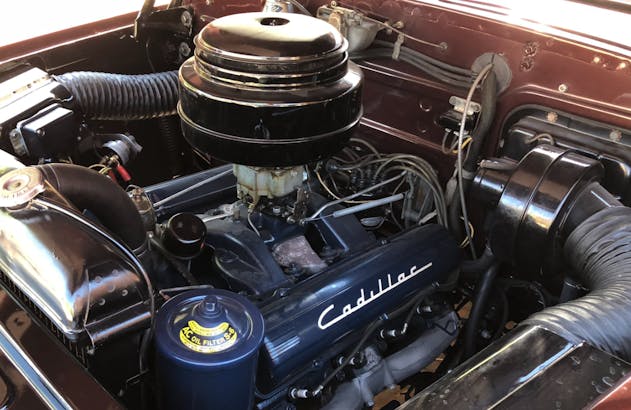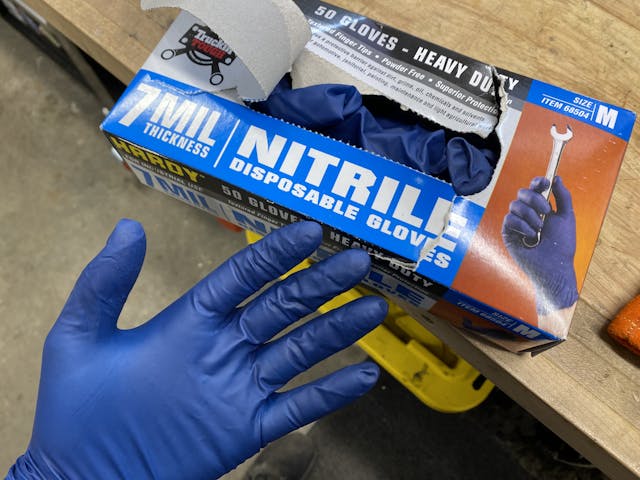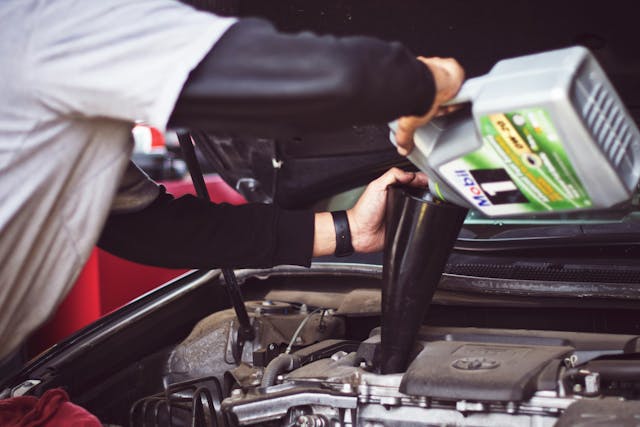8 oil change dos and don’ts
It’s a small job that somehow became a rite of passage for gearheads: Oil changes. The draining and refilling of engine oil is the first task that many budding wrench-turners undertake, and its certainly an important one. Like any other task in the automotive world, there are some pieces of institutional knowledge that comprise the key dos and don’ts for a smooth oil change. So let’s put these lessons learned out in the open, with the mission of shortening the process for newbies. And perhaps to reinforce some best practices for you veteran mechanics?
Don’t go crazy with warm-up

Modern oils are pretty amazing at suspending particles and contaminants, but there is still some junk that sinks down to the bottom of the pan. It needs to be stirred up to ensure it escapes when you pull the drain plug. Starting the engine and letting it idle for a minute or two is perfect for that final circulation. Run it any longer and you’re rewarded with nothing more than scalding hot oil that does nothing more than burn you. Before you pull that (drain) plug, give the engine a minute after shutting down, allowing the oil to drain to the pan from the nooks and crannies higher in the engine. But before you get underneath the vehicle to do the deed, remember you must…
Wear disposable gloves

Nitrile gloves keep you from soaking up solvents and oils into your skin. I’ve found 7mil thick to be a nice sweet spot of durable and affordable.
We all know the guy at the auto parts counter who has seriously gnarly hands from all the years being soaked in oil over decades of engine builds. That’s the visible damage. The invisible damage is sitting in your internal organs. All the hydrocarbons that get absorbed through the skin and are processed in our gut where they can’t be broken down. They end up accumulating in our body, which can cause serious health complications after years and years of chemical exposure. Preventing those issues is easy as putting on a pair of nitrile gloves. Use them even if it’s only for pulling the filter and drain plug, which you can do efficiently with…
The drain plug trick

It’s not groundbreaking, but nothing feels better than the perfect pull on a drain plug to ensure you don’t get any oil on your hand. The trick is pressure, not pulling. As you unthread the plug by hand, push in–against the bolt as in comes out–so the threads act as a seal with the outer edge. With a little practice you can get the pressure right (while not rocking the plug in the threads) and can spin the plug a full turn to feel for the “click.” That click means the bolt overlapped the last thread. With a swift motion away from the direction of oil flow, remove that now-loose plug. Presto! This can make thin viscosity oil changes much cleaner, and thick stuff like 20-50 can sometimes be spotless. In your excitement of not having a mess to clean up after draining, make sure you…
Don’t over tighten the drain plug or filter

It’s come to the point where stuck filters and stripped drain plugs are no longer a joke. Neither the filter nor plug require any real torque when installed properly. Use a small amount of oil to lube the filter’s rubber seal, then spin it into place. After the gasket seats on the housing, turn it only about three-quarter of an additional turn. Some applications might call for a full turn, but that is usually reserved for heavy duty equipment. Any tighter than what the filter manufacturers call for and you run the risk of deforming that rubber seal, which could cause oil to leak past the seal. That’s bad news. Any oil spillage is bad, so when you are filling…
Just use a funnel

The oil fill port on most engines is in that perfect spot where it looks like you could pour directly into it, except that’s a lie. They seem to be ideally located, but cleaning up if you miss (by even the smallest margin) can be a major pain. Are we really going to work so hard to spot and address leaks, to keep our engines clean, and just ruin it while doing routine maintenance?
I’m not. A funnel all but guarantees I won’t have to do any clean up after filling, even if I’m distracted or letting my 7 year-old niece do the filling. Putting in that fresh oil feels good, but be careful and…
Don’t overfill

This shows the rotating assembly without the oil pan and it’s easy to tell how oil at too high of a level would be bad.
Too much oil is just as bad as not enough. Seriously. The oil level in a wet-sump engine is carefully calculated to keep the rotating assembly from whipping through the oil. That action causes foaming, and oil foam pushed through the oiling system is the same as not having oil at all. I don’t need to tell you how bad that can be, so check the service or owners manual for the proper fill level. When done, look at the dipstick as a double check. Luckily, the empty oil containers you now have at this point are are perfect to…
Recycle your used oil

It’s never been easier to properly recycle used oil, so there is no excuse to do otherwise. Just about any auto parts store takes it, so they should be your first trip in your freshly serviced vehicle to “return” your oil. Be sure to capture oil in a non-contaminated pan so that the oil can actually be recycled. Coolant is the main enemy here, so be sure to flush your drain pan before the oil change. Luckily you don’t have to worry about how dusty or dirty the pan is, but other fluids can defeat the purpose of recycling. But before you make the trip to recycle the oil, be sure to…
Reset the computer (or write down your service date)

Modern cars have an oil life monitoring system. Whether you trust it is a personal preference, but for the sake of eliminating confusion, go ahead and reset it now. Most reset procedures involves cycling the ignition key and pressing the throttle pedal a certain number of times. The service manual will outline it, or a quick search to an online make/model specific forum will have the instructions. If your vehicles are of the manual variety, write down the oil change date in a log book. Or consider service tracker kept in the car or garage, as it keeps you from forgetting what’s been done. Not to mention thisa paper trail shows good stewardship to a potential next owner, which can mean an easier sale for more money.
In all, oil changes can be simple and rewarding for newbies and DIY enthusiasts alike. Following these best practices will not only keep your vehicle happy, but also make the experience better for you each time. Do you have something specific you add to this process? Let us know about it in the comments below.
***
Check out the Hagerty Media homepage so you don’t miss a single story, or better yet, bookmark it. To get our best stories delivered right to your inbox, subscribe to our newsletters.



All good pointers. I would add two things when installing the new oil filter: 1) Pre-fill the new filter with oil (as much as you can without spilling it everywhere). This will reduce the effects of dry starting. 2) Before installing the new filter, ALWAYS check to make sure the old rubber seal came off with the old filter. If it isn’t on the filter, then check the flange to make sure it didn’t stick to the motor. If you leave the old oil gasket and install a new one on top of the old one, you WILL experience a major oil mess when you start the engine. I made this mistake once. Now I ALWAYS check.
ABSOLUTELY! I have seen too many removed filters leave their O rings up inside the block. Hard to see so stare extra hard at the one you took off (or in the drain pan) to see that is it out. Blowing nice fresh expensive oil all over the floor is no fun……………..
The one thing that every one overlooks is that the oil filter should be filled & left to sit while the old oil is draining. The filter will absorb the new oil quickly. When you insall the filter no oil will leak out . This insures that on initial engine start up you will have instant oil preasure. If you don’t fill the filter , the engine can run without oil pressure untill the filter is full. Depending on the age of the engine or the wear on the engine, this could take a few seconds upwards to almost a minute. The oil viscosity can also effect this time. So multiply that by the # of times the oil gets changed over its life & that is along time to run your engine with out oil pressure or flow
Great article to remind me of the process that I follow and have trained my sons to follow. The only thing I would add is that with each oil change I also replace the seal washer on the oil pan drain plug. Thanks for the article.
Generally I find it easier and cleaner to change the filter first while the drain pan is still clean and empty. Handling a drain pan full of oil to change the filter can lead to a mess…
Great idea on a checklist. And while you are making the list, be sure to include “Reinstall and tighten the drain plug.” Can anyone else here raise their hand to the question “Have you ever poured fresh oil into the engine before installing the drain plug?” Aside from me, that is…….
You guys are never going to believe this one. First let me say on my older cars I change the oil at 2,000 miles. The everyday cars I follow the owners manual.
Anyways, back in 1972 a college buddy worked for one of the big 3 auto manufacturers for the summer. They did oil testing that summer. What they decided was, if you were going to keep your car for years. You should change it every 2,000 to 3,000 miles. If you were going to keep it for a year or two. Don’t even bother changing it.
Go figure that philosophy back then.
In the September 2019 issue of Roadracing World and Motorcycle Technology their study found that they got more of the bad stuff out by draining the oil cold and unstirred. On another note, at Barber Vintage Cycle Show I asked one of the owners of a premium synthetic oil company about changing oil based on time vs miles. He stated that the concern was wearing out the additives and that they wore out with miles. Though he did appreciate all the people who regularly bought his oil based on time rather than the number of miles the vehicle had run.
What JOE said… when I was little, on the farm, watching my Uncles change the oil on a ’48 Chevy truck, I asked them “Why do you change it?” One of the old neighbors (with a chaw in his cheek) muttered “Oil’s cheap… Motors ain’t” – says it all. … and not mentioned but INCREDIBLY IMPORTANT is to always restart the drain plug WITH YOUR FINGERS! Yeah… WE know that, but it’s amazing how many cross-threaded plugs happen every year. (mostly by “those oil change places” run by idiots)
I have installed and used the Fomoto brand quick change valve to replace the drain plug on all my vehicles. No more messes and you can put a hose on it and drain it directly into a container (I drain into old one gallon oil jugs). There are other brands that make these quick change valves – I just like to stick with ones that have worked good for me, but the other brands will probably work just as well.
I have a newer Eco Boost Ford that has a giant hole and poorly designed oil plug that is almost guaranteed to get oil everywhere except the pan. I found a company that makes a quick change replacement and installed it with great success and no more messes.
I have performed tests to make sure that all of the oil drains out with each of the quick change plugs and each has worked admirably.
$40 very well spent. I have them on all my cars.
I have several collector cars, plus my two daily drivers. Keeping track of service intervals was a real pain. But now I use a white board that I have laid out in a grid pattern. I have marked when I serviced the vehicle. Noted the filter number, type of oil, weather I greased the chassis etc. I also have noted on the board any other pertinent information such as when the battery was replaced,fuel/air filters and when I added Sta-Bil fuel stabilizer.
A trick I learned from a wise enthusiast was to change oil every 2500 miles. This frequency is easy to remember just by looking at the odometer (easier than remembering a 3000-mile interval). And while a 5000-mile interval is equally easy to remember just by looking at the odometer, that may be too infrequent for most enthusiasts.
Nitrile gloves are unnecessary and expensive, I’ve never gotten oil on my skin using the much cheaper latex gloves.
Stupidly, most owners’ manuals list the capacity of crankcases separately from the recommended viscosity and oil change intervals. A simple sticker or info on the dipstick would save paging through the manual every 5000 miles. I have a 3.5 liter 6 cylinder Nissan that only takes 3.5 quarts of oil and a 4 cylinder Hyundai 2.4 that takes 4.8 quarts
IMO I’d reword one statement in this article to read (somethung like this):
“All the hydrocarbons that get absorbed through the skin into the blood stream and are (primarily) processed in our liver where they can’t be broken down safely…”
In the gut?
I don’t do oil changes, when she starts rattlin add 3 quarts till the next time. Voila oil is fresh. 😉
Hey Nitro -just wanna jump in to say I miss the photo updates of your pickup’s SBC build!
Love it…lol
My oldest brother had a Valiant with the indestructible slant 6. He would “change the oil” by adding a quart as needed. Darn thing ran over 257k …..
but I’m still not a Mopar guy.
I enjoyed the tale about the import of the rusky cars! Thanks.